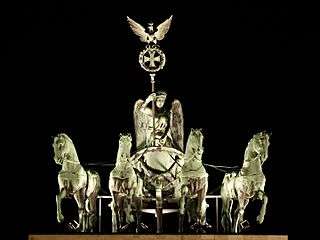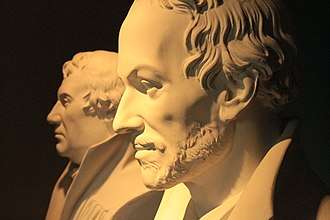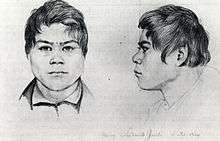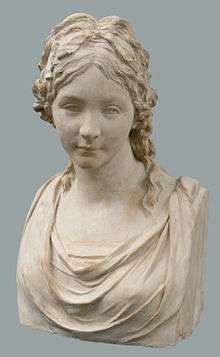Johann Gottfried Schadow
Johann Gottfried Schadow (20 May 1764 – 27 January 1850) was a German Prussian sculptor.


His most iconic work is the chariot on top of the Brandenburg Gate in Berlin, executed in 1793 when he was still only 29.[1]
Biography
Schadow was born in Berlin, where his father was a poor tailor.
His first teacher was the sculptor Tassaert, patronized by Frederick the Great; the master offered his daughter in marriage, but the pupil preferred to elope with a Jewish girl, Marianne Devidel, to Vienna, and the father-in-law not only condoned the offence but furnished money wherewith to visit Italy.[2] Three years' study in Rome formed his style, and in 1788 he returned to Berlin to succeed Tassaert as sculptor to the court and secretary to the Prussian Academy of Arts. Over half a century he produced upwards of two hundred works, varied in style as in subjects.

Among his ambitious efforts are Frederick the Great in Stettin, Blücher in Rostock and Luther in Wittenberg. His portrait statues include Frederick the Great playing the flute, and the crown-princess Louise and her sister Frederica. His busts, of which there are more than one hundred, include seventeen colossal heads in the Walhalla, Ratisbon; Goethe, Wieland, and Fichte were modelled from life.

Of church monuments and memorial works thirty are enumerated; yet Schadow hardly ranks among Christian sculptors. He is claimed by classicists and idealists: the quadriga on the Brandenburger Tor and the allegorical frieze on the facade of the Royal Mint, both in Berlin, are judged among the happiest studies from the antique. Schadow, as director of the Berlin Academy, had great influence. He wrote on the proportions of the human figure, on national physiognomy, etc.; and many volumes by himself and others describe and illustrate his method and his work.

His interest in physiognomy is documented by the drawing he made of Harry Maitey, the first Hawaiian in Prussia.
Today, some of his sculptures and busts are displayed in the Friedrichswerdersche Kirche and the Alte Nationalgalerie in Berlin.
Schadow developed a friendship with Johann Wolfgang von Goethe when at first Goethe's son visited Schadow in Weimar. Schadow created 12 bronze medals of Goethe. One such medal is in the property of the British Museum.[3] In 2009, one such medal was bestowed by the Goethe Institute upon Dr. Daisaku Ikeda in recognition of his contributions to peace and Goethe's philosophy.[4]
He died in Berlin in 1850. His sons Rudolph and Friedrich Wilhelm were notable for sculpture and painting, respectively. He was the grandfather of admiral Felix von Bendemann of the German Imperial Navy.[5]
Family
He was uncle to the sculptor Emil Wolff.
References
- https://www.britannica.com/biography/Gottfried-Schadow
- Hertz, Deborah. Jewish High Society In Old Regime Berlin, 2005.
- Bronze medal of Johann Wolfgang von Goethe, by Johann Gottfried Schadow, Explore, Highlights, British Museum, retrieved 4 June 2012.
- "Goethe Society in Weimar Commends Daisaku Ikeda for His Commitment to Peace and Promotion of Goethe's Achievements". Daisakuikeda.org. 2009-12-12. Retrieved 2013-12-15.
- Judentum in Deutschland, Luebeck-kunterbunt.de (in German)
Notes

External links
| Wikimedia Commons has media related to Johann Gottfried Schadow. |

